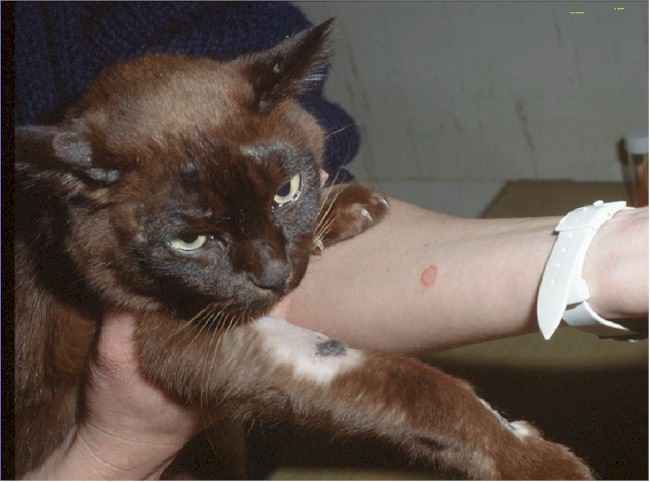Cat Alopecia
Cat losing hair is a condition called cat alopecia. There are many possible reasons for hair loss in a cat, some of them serious and some of them not so serious. If your cat has hair loss, you should take her to the vet for a diagnosis and treatment.
Cat Alopecia Symptoms
Alopecia usually causes patches of hair loss. The location of the hair loss will help with the diagnosis.
Your cat may have other symptoms, as well. Her skin may be red or inflamed where the hair is falling out. She may be scratching or licking those areas. She could have a myriad of other symptoms, depending upon the cause of the hair loss.
Diagnosis for a Cat Losing Hair and Treatment
It can be somewhat difficult to diagnose cat alopecia because there are so many possible causes to rule out. Your vet will start with a thorough physical exam. He or she may do a number or special tests, such as blood tests, a urinalysis, examining your cat’s skin under a special light, scraping her skin for some cells to examine under a microscope, and/or a skin biopsy.
Cat Skin Allergies and Alopecia
Cat skin allergies are a common cause of a cat losing hair. Cats can be allergic to things in their environment, such as dust, pollen, and mold. This causes red, inflamed spots on the skin, itching, and hair loss. Scratching can make hair loss worse. Allergies are treated with steroids and antihistamines. Your vet can perform allergy tests to determine exactly what that is causing the allergic reaction. If necessary, she can be given allergy shots to desensitize her to that substance.
Food allergies are another possible cause of a cat losing hair. Symptoms look similar to those in cats with environmental allergies. Food allergies are less common than environmental allergies, though. The way to deal with food allergies is to place your cat on a special elimination diet which removes most food types from the diet to see if the reaction disappears. Single foods are gradually added back in. You veterinarian can provide instructions for how to get started.
Alopecia and Cat Fleas
Flea dermatitis can cause cat alopecia. This is an allergy to the saliva from flea bites. It causes small, crusty red bumps, hair loss, and intense itching. Because of the severe itching, your cat may damage her skin and develop a secondary bacterial infection. Your cat must be treated for fleas, and her environment must be treated for fleas as well. If she has a bacterial infection, that will be treated with antibiotics.

Picture of Cat Hair Loss
The hair loss for flea-bite hypersensitivity is usually in the back half of your cat and areas where your cat cannot easily reach.
Treatment for cat losing hair due to this condition includes the use of flea removal/prevention products such as Frontline PLUS for Cats , prescription medications such as glucocorticoids and antihistamines to help with itch. You might also want to supplement the diet with Omega 3, 6, 9 fatty acid Caps which are good for the skin.
Ringworm and Cat Losing Hair
Ringworm is a fungal infection that can cause hair loss. It is not really a worm, but is called ringworm due to its circular appearance. It looks like red circles with white centers. It is treated with both oral and topical medications.

Picture of Cat Hair Loss - Ringworm
Feline Alopecia and Cat Thyroid Disease
Hair loss can be a symptom of a thyroid disorder called hyperthyroidism. A blood test can determine if your cat’s thyroid is functioning properly. If not, your cat may require surgery to remove part of the thyroid gland.
Cat Skin Fungus (Dermatophytosis)
Cat losing hair due to skin fungus is usually contracted when your cat comes in contact with fungus spores in the dirt or on another animal. The fungus attaches itself to the hair or skin. Signs of infection are seen between 2 to 4 weeks after exposure. Fungus prefers dead cells such as hair and nails and stops spreading when it comes in contact with healthy skin.
The most noticeable symptom of skin fungus is brittle areas or patches of hair which will look the the hair has been closely shaved in the area affected.
Symptoms in kittens include red areas that can be seen on your cat's paw, face and ear. These areas may look like they have a crust that is gray/white in color, covered in wet looking scabs or
The area may develop a thin, grayish white crust or a thick, moist scab. The area may or may not be itchy. Your kitten might spread the fungus all over the body when grooming.
Your veterinarian's diagnosis will be based on a skin test. Treatment options include anti-fungal shampoos and creams.
Cat Psychogenic Dermatitis
Finally, there is psychogenic dermatitis. This is a condition is which cats lick themselves excessively, causing hair loss. It may be caused by anxiety, stress, or boredom. If possible, the source of stress must be relieved, but sometimes behavior modification medication is necessary.
These are the most common causes of cat alopecia. There are other, much rarer causes, but your vet will investigate these causes first.
Other Causes of Cat Losing Hair or Cat Alopecia:
A cat can also loose its' hair due when taking certain drugs (known as antimitotic drugs) or when the body is under stress from a severe disease. Other stresses on your cat's body such as fever, shock or surgery can also cause the hair to stop growing within 1 to 3 months of the problem. If you can identify any of these as the cause of the hair loss, then the problem should eventually heal itself, particularly if your cat is no longer taking a drug that caused the problem.
Sources:
Causes of Hair Loss
Holly Nash, DVM
The Center for Food Security and Public Health
Iowa State University
College of Veterinary Medicine
No comments:
Post a Comment